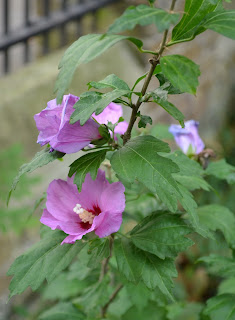11
September 2015
We started from Richmond tube station and had to walk a number of streets
south to the Richmond Gate entrance to Richmond Park
Sweet chestnut at Bishop's
Pond
Plentiful fruit
Dead wood was left
on the ground as a habitat for saproxylic insects for which the Park is a good
site.
One of our intentions on this walk was
to find and identify Rubus londinensis,
not uncommon in this region, with Tooting Bec and Wimbledon Commons Richmond
Park
Rubus
leucostachys
Richmond Park
Nearby was a
parasol mushroom, appearing to be typical Macrolepiota
procera, the commonest one.
There were many
veteran oaks Quercus robur scattered
around, many of them old pollards, and also herds of red deer
Old pollard oak
We walked down the
west side towards Pembroke Lodge and the gardens there, where, on a sheltered
slope around a young tulip tree Liriodendron
tulipifera, clumps of Meadow Saffron Colchicum
autumnale were flowering in good condition, not flattened by storms as most
often seen.
Meadow saffron
King Henry's Mound
provided a good viewpoint to the west, although to the east the view of St. Paul
View from King Henry's
Mound
South of Pembroke
Lodge, currently hosting two different wedding receptions, we found Hornbeam
Walk. This unusual avenue of hornbeams
includes a few old specimens, but most are young, presumably replacing ones
that died. Like the chestnuts these had
fruited abundantly, so much that the ground was thickly carpeted.
Hornbeam Walk
Hornbeam seeds carpeting
the ground
We then walked to
the south of the park to Isabella
Gardens
Weeping willow
Spindle
We followed a
stream from them pond through the centre of the gardens. This stream has abundant Royal Fern Osmunda regalis. Young Judas trees Cercis siliquastrum, emulating the spindle, were just turning red.
Royal ferns along stream
Judas tree
We left the
gardens by Broomfield Hill Gate and proceeded to the centre of the park past
more old oaks and sweet chestnuts, stopping at a wooden bench briefly for a
snack, while the sky presented a fascinating tableau of cirrus, cumulus and
altostratus, in addition to the usual contrails in the flight path from
Heathrow.
We skirted
Spankers Hill Wood heading SE towards Robin Hood Gate.
Spankers Hill Wood
Straight across
the road was an entrance to Wimbledon Common.
This has a completely different aspect from Richmond Park London
Rubus
londinensis
leaflets long-stalked, cuspidate
Rubus
londinensis
stem blunt-angled, hardly pubescent, prickles slender, patent, some in pairs
Rubus
londinensis
panicle hairy, prickles sparse and small
It was difficult
to navigate through the overgrown common (a compass would be useful) and we
could not follow the route we meant to, but at least managed to end up in the
SE corner as intended, where there is the open grassland of Wimbledon Green and
a large (but bare) expanse of water, Rushmere Pond. The margins of the pond were unfortunately
dominated by the invasive New
Zealand
Rushmere Pond
We then had urban
streets to negotiate to get to Tooting Bec Common. Coming out on the High Street and going NE
along Church Road Wimbledon " Village " Burghley Road
Dairy Walk
We now headed east
through well-cared-for streets, London
Passion-flower
At the bottom of
Church Hill, where we turned left (NE), a large old oak survived as a pavement
tree.
Old oak at bottom of
Church Hill, Wimbledon
Past a school we
bore right and east again along Leopold
Road Gap Road Plough Lane Wimbledon , and passed
the Greyhound Racing Stadium. At the
roadside there were generally few adventives of interest, but extensive groups
of Shaggy Soldier Galinsoga quadriradiata
and a small clump of Hairy Finger-grass Digitaria
sanguinalis, the first time we had seen this alien grass (probably from
birdseed).
Hairy finger-grass
We eventually came
out on Garratt Lane Streatham
Cemetery
We left on the
east side and walked more streets, including Fishponds Road, where a street
sycamore had Girdled Knight Tricholoma
cingulatum at its base, to Tooting Bec tube station and Tooting Bed Road,
which brought us to the corner of Tooting Bec Common. We entered past a largely dried-out pond area
with many introduced plants such as Forrest's Tutsan Hypericum forrestii, Confused Michaelmas-daisy Aster novi-belgii, and a robust rampant bramble that turned out
also to be an alien, Rubus armeniacus.
Forrest's tutsan
Confused Michaelmas-daisy
Rubus
armeniacus
with its thick grooved stems and stout prickles
Native plants at
the pond included Perennial Wall-rocket Diplotaxis
tenuifolia, Burnet rose Rosa
pimpinellifolia (presumably planted, but spreading as a wild shrub), and
Hawkweed Oxtongue Picris hieracioides,
with its bristly stems and curled back flower-bracts, also thriving.
Hawkweed oxtongue
Again we saw a
Brown Rat, a creature we usually see in the wilder London
Many-flowered rose with
its large sprays of small hips
At the north end
of the common, beside a railway, we went westwards to Balham tube station, near
which was this mural by Tod Hansen.
Lamberts
Restaurant near the station provided a chance of good food before catching the
tube for the journey home.






















































































